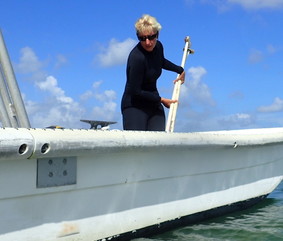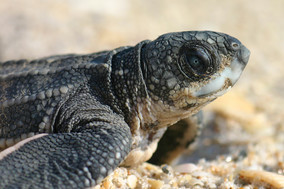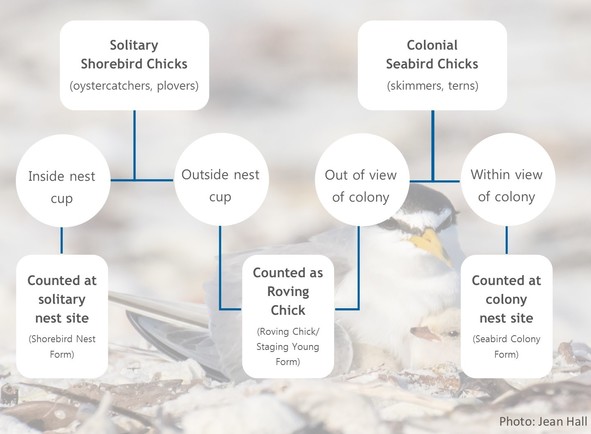Events:
June 8: World Oceans Day
June 13: Shorebird Walk at Matanzas Inlet
June 22: Tigertail Beach Nesting Shorebirds
June 27: Seabirds and Plastic - A Deadly Combination
Reminders:
June 10-16: The June count window for the Breeding Bird Protocol. Whenever possible, weekly surveys are preferred for routes with active nesting; it helps capture information about peak counts.
All Summer: Beach stewards are needed at important beach nesting sites. Check out the map of local stewardship opportunities and contact us to get involved!

Partner Spotlight: Janice Duquesnel of the Florida Keys Shorebird Partnership
Janice Duquesnel is the District Biologist for Florida State Parks in the Keys. She has been working with the Florida Park Service for 24 years. Her passion for the environment comes across in all that she does. She coordinates shorebird surveys with all the State Parks in the Florida Keys and does many of the surveys herself.
As a FSA partner, Janice is fastidious in pre- and post-season meeting note taking and always sends reminders to staff and partners of upcoming count windows. Not only does she help with the breeding bird surveys but she also makes sure that as many sites as possible are surveyed during winter shorebird surveys. She does this on top of her numerous other duties as District Biologist.
When Janice isn’t working she enjoys studying Dutch and spending time with her dog, Benjamin. Thank you, Janice, for your dedication to shorebirds and wildlife. We are very lucky to have you as a part of the Florida Keys Partnership of the Florida Shorebird Alliance!
|

Calling All Bird Stewards!
Do you like spending time on the beach and talking about birds to beach goers, to help our remarkable shorebirds and seabirds thrive in the process? If so, sign up to become a Bird Steward!
Bird Stewards are needed at shorebird nesting areas during the breeding season, especially during high beach traffic weekends, and holidays. Learn more about becoming a beach steward.
To sign up, contact your local Audubon Stewardship Coordinator below and they will get you trained to be a Bird Steward. Your stewardship is greatly needed and appreciated!
Northeast Florida:
Chris Farrell – Nassau, Duval, St. Johns, and Flagler counties: cfarrell@audubon.org
Florida Panhandle:
Rebekah Snyder - Rooftop monitoring and chick-checking at various sites across the Panhandle from Escambia to Leon counties: rsnyder@audubon.org
Bonnie Samuelsen – beaches in Franklin, Gulf, and Bay counties: bsamuelsen@audubon.org
Susan Cerulean - St. Vincent NWR: susan.cerulean1@gmail.com
Caroline Stahala – Escambia to Walton County: cstahala@audubon.org
Southwest Florida:
Ann Paul - Wading bird nesting colonies in Hillsborough, Pasco, Pinellas, Manatee, and Sarasota counties: apaul@audubon.org
Hannah Byrne - Fort Desoto Park and St. Petersburg Beach, Pinellas County: hannah.byrne@audubon.org
Erin McGrath - Indian Rocks Beach or South Clearwater Beach, Pinellas County: erin.m.mcgrath@audubon.org
Jessica Lewis - Three Rooker Island, located north of Honeymoon Island with boat transportation provided for volunteers: jessica.lewis@audubon.org
Jeff Liechty – Rooftop monitoring and chick-checking at various sites in Pinellas, Hillsborough, Manatee, and Sarasota counties: jliechty@audubon.org
Kylie Wilson - Siesta Key, Lido Key, Longboat Key, Sarasota area: kwilson@audubon.org
Andrea Centola - Fort Myers Beach, Lee County: andrea.centola@audubon.org
Natalia Hank – Marco Island/Sand Dollar Beach, Naples area: natalia.hank@audubon.org
Photo: Ginger Goepper
|

Sea Turtle and Shorebird Monitors: When You're on the Beach
Summer is in the air, and for shorebirds and sea turtles, eggs are on, or in, the beach. And that means Shorebird Alliance Partners and Marine Turtle Permit Holders (MTPH) are also on the beach. If you’re one of the persons working for the conservation of Florida’s sea turtles and shorebirds, there are a few things to remember during your time on the sand.
Sea turtles access the beach at night to bury their eggs within the sand, usually ten inches or deeper. The eggs of shorebirds, however, are laid on the open sand. Also, unlike sea turtle hatchlings, flightless chicks remain on the beach until they are fledged – and they don’t just remain in the posted areas! Chicks of both colonial and solitary nesters can be anywhere on the beach from the waterline up to the dunes, and they can travel far from the original marked nest site. The primary defensive response for flightless chicks is to freeze and press against the sand surface, which makes them very vulnerable to foot and vehicle traffic.
During the shorebird nesting season, Florida Shorebird Alliance partners post nesting areas by encircling the area with posts and flagging or twine. The time frame from nest initiation to fledging of seabird and shorebird chicks is typically no longer than 60 days and determines how long an area is posted. However, because nests are asynchronous (not all nests are initiated on the same day), if there is more than one nest within a posted area such as in a large seabird colony, this time frame may stretch out over a longer period. Because each posted area is unique, it is best for MTPH and shorebird monitors to coordinate closely to determine the anticipated completion date for nesting at any site.
When surveying on the beach please remember to respect posted areas, as often there will be eggs and chicks on the ground. Any disturbance within the site could cause the adult birds to flush, leaving eggs and chicks vulnerable to predation, exposure to the intense heat from the sun, or starvation. Chicks may become separated from their parents during a disturbance event, or adults may permanently abandon a nest due to human disturbance.
Seabirds and shorebirds are protected under state and federal laws, and there can be legal ramifications for anyone entering a posted area, even with the best intentions. MTPH that survey a beach with posted shorebird nests must be extra vigilant, both on an ATV and on foot, during early morning surveys to watch for shorebird chicks and fledglings. Sea turtle nest surveyors must respect the posted area, entering only if specifically authorized to do so by FWC staff at MTP@myfwc.com.
It is still important to get accurate information on any sea turtle crawls that might occur within posted shorebird areas or adjacent to posted nests. Marine Turtle Permit Holders should observe the crawl to the degree possible from the outside of the posted area and install a marker outside the postings or away from the solitary nest to indicate the approximate location of the crawl or nest. Once the postings for the birds are removed, the MTPH can enter the area and post as large a section as needed for protection of any potential sea turtle nests. Sea turtle nest inventories should be done after the postings are removed. If you are a Marine Turtle Permit Holder or a shorebird monitor and have questions about posted areas, please contact shorebird@myfwc.com or mtp@myfwc.com and we will help you.
Thank you for your work protecting Florida’s sea turtles and shorebirds!
|

 |
It's Chick Season!
Chicks are hatching all over the state! Do you know how to enter your chick observations into the Florida Shorebird Database (FSD)? In the FSD, the place to enter chick observations depends largely on the species and location of the chick.
If you see a solitary shorebird chick, you must first ask yourself: is the chick inside or outside the nest cup? Most of the time, shorebird chicks will be observed outside the nest cup, which means you should enter the observation on the Roving Chick/Staging Young Form. In the very rare instances where you observe a shorebird chick still inside the nest cup, it is considered a nestling and can be recorded on your Shorebird Nest Form.
If you see a seabird chick, you must first ask yourself: is the chick within sight of a colony? Downy and feathered seabird chicks will always be within sight of their colony, but sometimes flight-capable seabirds can spend time “staging” beyond sight of their original colony. If the seabird chick is within sight of a colony, you can enter those chicks on the Seabird Colony Form. But if you see staging seabirds – flight-capable young that are out of sight of a colony – you can record them on a Roving Chick/Staging Young Form.
But what should you do if you observe a solitary shorebird pair acting like they have chicks, but you can’t see the chicks themselves? If you are confident that this pair had a nest that could’ve hatched and has chicks, you can enter that information on a Roving Chick/Staging Young Form. In the form, simply enter a zero in each chick age category, enter the adult count, then write a comment that explains why the behavior you observed leads you to believe there is at least one chick.
As always, we are happy to help answer any questions about chick observations and data entry. If you’re unsure about anything, just email FLShorebirdDatabase@myFWC.com!
|